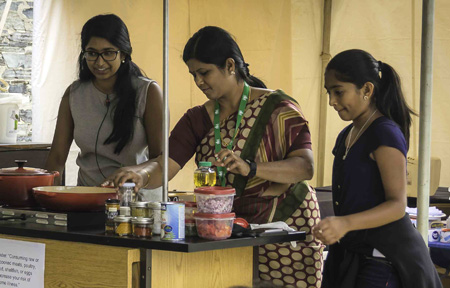
Guest blog by Millie Rahn
Harvest is past and Thanksgiving is upon us, the perfect time to recall recipes and stories, and celebrate the traditions that make us who we are as individuals, families, and communities. We do this in kitchens, at tables, or in other formats where we remember and reflect on the foods we eat, the ways we acquire and prepare them, and the symbols and meanings they have for us, past and present.
As a folklorist, I’m still savoring the bounty of summer’s riches showcased and shared at regional festivals, particularly in Lowell in late July, where I curate and present the foodways demonstrations. The foodways stage at this year’s 31st event was a festive sampling of tastes, cultures, techniques, and stories featuring foods with ties to land or sea.

Foodways complemented the larger folklife area theme of coastal and inland traditions exemplified by tradition bearers who produced items such pottery and baskets used to gather and/or store foods, or the quahog and other shells that are turned into wampum by Wampanoag and Narragansett artists, or ship’s wheels, horse saddles, and blankets for gathering and transporting foods, or temple ornaments used in the blessing of the bounty.
On the makeshift kitchen stage, both home and professional cooks talked about their individual history and culture. Each assembled a recipe while sharing stories of their homelands and the foods they grew up with, and recipes they adapted and maintain here, and then let audiences sample the finished fare—from Lithuanian pickles to Caribbean and Asian poultry and seafood, rounded off with Southwest chili adapted to coastal New England.


Irena Malasauskas emigrated from Lithuania, where her mother always kept wooden barrels of pickles and of sauerkraut in their kitchen. Now Irena makes pickles regularly, keeping them in plastic and glass jars, and even assembled ready-to-eat ones in plastic bags. Pickles, we learned from Irena’s husband and from her granddaughter visiting from Germany, don’t last long in the Malasauskas household.

Geetha Raju, originally from Tamil-Nadu in southern India, made a South Indian shrimp curry, ably assisted by her daughters, Shuruthe and Laya, who are learning the family traditions of cooking and baking. While Geetha here uses tinned coconut milk, she noted that at home in India, which she visits as often as she can, they simply can go outside and pick a coconut off a tree. Laya wants to go into the culinary arts; I suspect we’ll be seeing more of her on the Lowell foodways stage.

Gaitskell Cleghorn, Jr., known as “Chef Gates,” teaches culinary arts in an after-school program for middle school students. He and his partner, Mika Brinson, have Jamaican roots. They talked about the variety of fresh ingredients in Jamaica, where chicken is widely available, either in shops or raised in backyards, and the ease of the cooking and eating on the beach or on rafts in the water in a mild climate. They, too, used coconut milk for their chicken dish, while giving tips on slicing vegetables safely and easily, and quizzing the audience on culinary knowledge and the science of cooking.

Han-Ting Lin is a physician from Taiwan where, she says, fish is a staple in markets and “is a must” at New Year’s Eve dinner. As an oncologist and enthusiastic home cook, she advises “everything in moderation” and talked of the benefits and ease of preparing simple, healthy, and inexpensive meals from scratch, especially in a wok. She uses a square-bottomed wok that she brought from Taiwan, but noted similar ones are available in Boston’s Chinatown and can be used on either electric or gas stovetops without an adapter. She shared her favorite fish marinades, which she served on different days with squid and salmon–a commercial Korean barbecue sauce, and her own blend: 1 cup olive oil, a “big ginger root,” and 1 ½ tablespoons bottled curry powder.

Patricia Hazard and her sister Viola Solano, dubbed the “Chili Sisters” onstage, made two kinds of Southwestern chili from their mother’s recipe originally from New Mexico, whence they ordered the special chili pepper ingredients for the Southwest flavor they remember from childhood. One sister likes beans in her chili; the other does not, but the basics are the same and each has been making her chili recipe for decades in coastal New England.
Catch us next year at the 32nd Lowell Folk Festival, when our foodways theme will be FLATBREADS & WRAPPED FOODS. Flatbreads, often called pancakes, can be served “as is” or topped, or wrapped and filled with sweets or savories. Whether you call them ploys, hoe cakes, crepes, blintzes, chapattis, johnnycakes…they’re delicious. Come taste for yourself.
